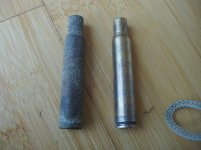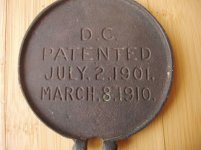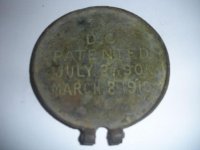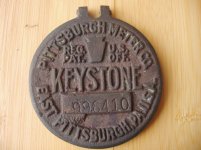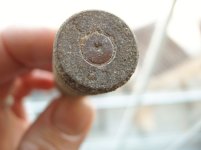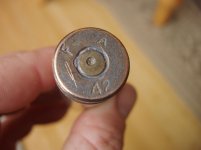kendallkirk
Forum Supporter
I have been using electrolysis to clean old iron tools since long before I began swinging a detector and digging in the dirt. Just thought I would share my setup because it's not influenced by some of the ones here and may offer some new ideas to everyone.
Disclaimer: I am not suggesting that you do this, just telling you how I do it. Research all safety aspects in everything you do. For more research on safety issues, etc., please search internet for "electrolytic rust removal" or "electrolysis + rust removal" and you will find a number of sources.
Sounds complicated, but it's not...I'm just detailed. Bear with me here and I know you will find this worthwhile. If you're going to want to clean ferrous parts that you dig up, this is the only effective way in my opinion.
There many other threads in this "Make it or fix it yourself" section that have other methods detailed. This is my method. I do not use stainless steel for my sacrificial anodes because chromium is then dissolved into the electrolyte solution. Dissolved chromium can be toxic even on skin contact.
What you'll need: 5 gal plastic bucket, 1 AC/DC cell phone charger (wires clipped and stripped near plug that goes into phone...any AC/DC transformer will do...AC/AC will not do), 2 empty large baked bean cans (or other...coffee cans also work), water, baking soda, light gauge wire, alligator clips, and a volt meter. For larger parts to be cleaned, rubbermaid containers or plastic drume work well and use more cans (to surround object). For longer skinny parts, a section of capped plastic gutter works great. Any plastic container will do.
Cut top and bottom out of cans with can opener, then cut along height of cans with tin snips and gloves and straighten out. Cup it a little so it will free-stand in bucket. Strip wire on AC/DC transformer (make sure bare ends aren't touching), plug in to wall, and check polarity with volt-meter. Important: Positive lead goes to sacrificial anode (cans), negative lead goes to part (chain in your case). Mark them now with tags of masking tape and a Sharpie.
Add water and maybe 1/2 cup (can't remember correct proportion here, but I can tell you how to adjust to get it right...it will actually depend on the voltage of your transformer anyway). Mix until dissolved. With transformer unplugged and the two bean (coffee, whatever) cans standing upright in bucket (one on each side), hook aligator clip from positive lead on transformer to one of the cans (impt: above water line or alligator clip will oxidize away with time). Take another short piece of wire with two alligator clips on either end and hook one to each can above water line (so that both cans are hooked to the positive lead in series. The idea here is to sort of surround the part to be cleaned with the cans (sacrificial anodes).
Hang your part to be cleaned from a piece of baling wire or something (I use aluminum electric fence wire), suspended from a board (pipe, dowel, anything strong enough) that spans the top of the bucket between the cans sticking out. Part to be cleaned should be completely submerged, as close to the center of the bucket as possible, and not definitely touching either of the cans.
Hook an alligator clip to the negative lead from the transformer and clip it to the part to be cleaned. Several clips can be daisy chained together to do multiple parts at once or to clean a part that is segmented, where electricity will not conduct well from one segment to another. This will be the most troublesome thing if you're cleaning something like a chain because the individual links will not conduct well from one to another...an alternative is to put the chain in a steel or aluminum mesh bag of sorts, bind tightly and just hook one clip to the bag (this is how I clean many rusted nuts and bolts or other small parts at one time).
Almost done...I plug the transformer into a gfci outlet for safety. Before you plug in, make sure that there are no places where the part is touching the can or you will have a short. Plug it in and closely monitor the temperature of the transformer box for at least the first 20 minutes or so.
If it is getting hot to the touch then you need to dilute your electrolyte solution (there is too much conductivity in it). Just pour out some of the solution (10-20% of it) and replace with tap water. THIS IS IMPORTANT: Fix the problem if transformer is getting hot...otherwise it may explode, releasing potentially harmful compounds into the air.
If it is warm to the touch and seems to stabilize without continuing to increase in temperature, then your solution is good.
If it is cool to the touch, then consider adding some baking soda to the solution.
There is a way to get this exactly right by measuring the resistance and comparing it to calculations from specifications on the transformer, which I can explain if you're interested, but this "hot, warm, cool" test works fine for me. Different voltages will require different electrolyte strengths (or different concentrations of baking soda).
In time, the water level will drop and it will get murky. There is never any reason to change the electrolyte solution nor to add baking soda once you have it right. Just keep adding water weekly or monthly to make up for evaporation as needed. It is environmentally sound also to never dump the solution due to heavy metals that may be dissolved in it. If you're never going to use it again, allow all of the water to evaporate and then dispose of the bucket/dry contents properly. I keep two electrolysis setups continually running and just keep adding water every once in a while.
What you should see immediately in the bucket is small bubbles forming from your part to be cleaned (if not, then you are not alligator-clipped well enough to the part). These bubbles are hydrogen and oxygen from the splitting of water. The action taking place is an electrolytic reduction that is actually converting some of the iron oxide back into iron.
Since the hydrogen and oxygen can be flammable or even explosive if allowed to accumulate, make sure to set this up somewhere outside (I do mine on a screened porch with no problems). The small amount of hydrogen and oxygen is not a big deal unless it can accumulate.
Depending on the size of the part and the current of the transformer, you can periodically (maybe every 6hrs, maybe 12 hrs, maybe 2 days, you'll have to experiment with time period) pull out the part occasionally, brush it under cold water with a brass wire brush. The scale will get easier and easier to brush off each time. For lightly rusted parts, I only have to brush once (i.e. only one cycle of electrolysis) and then I'm ready to preserve (no more trips back into the bucket). Make sure to unplug transformer any time you reach into the bucket. And have dry hands when plugging/unplugging. If you use a power strip, then you can just flip the switch.
Once you're happy with the amount of cleanliness (there's no reason why all rust won't all go away with enough time in the bucket), do a final rinse/wire brushing, immediately dry part with towel or paper towels and then preserve shortly thereafter or it will start to rust again. Preservation can be a coating of machine oil or better yet, some clear floor wax (I heat mine in a $2 crock pot from the thrift store and brush it on with a paint brush...wax is easily removed with a hair dryer if you ever wanted to).
I know that you will find this to be superior to any other method that you try. Museums often use it to clean parts from shipwrecks, archaeology digs, etc. For steel and iron, you can leave the part in there indefinitely without any harm...if it's ferrous, the part will not degrade whatsoever with time. In cleaning other metals though (aluminum, silver, copper, etc. such as you may have with coins) you must only leave part in solution hooked up for very brief periods (15 minutes or so) and check because it will degrade these parts to literally nothing with enough time.
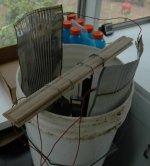
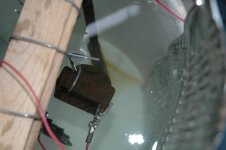
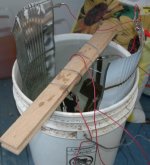
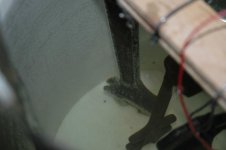
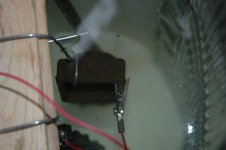
Disclaimer: I am not suggesting that you do this, just telling you how I do it. Research all safety aspects in everything you do. For more research on safety issues, etc., please search internet for "electrolytic rust removal" or "electrolysis + rust removal" and you will find a number of sources.
Sounds complicated, but it's not...I'm just detailed. Bear with me here and I know you will find this worthwhile. If you're going to want to clean ferrous parts that you dig up, this is the only effective way in my opinion.
There many other threads in this "Make it or fix it yourself" section that have other methods detailed. This is my method. I do not use stainless steel for my sacrificial anodes because chromium is then dissolved into the electrolyte solution. Dissolved chromium can be toxic even on skin contact.
What you'll need: 5 gal plastic bucket, 1 AC/DC cell phone charger (wires clipped and stripped near plug that goes into phone...any AC/DC transformer will do...AC/AC will not do), 2 empty large baked bean cans (or other...coffee cans also work), water, baking soda, light gauge wire, alligator clips, and a volt meter. For larger parts to be cleaned, rubbermaid containers or plastic drume work well and use more cans (to surround object). For longer skinny parts, a section of capped plastic gutter works great. Any plastic container will do.
Cut top and bottom out of cans with can opener, then cut along height of cans with tin snips and gloves and straighten out. Cup it a little so it will free-stand in bucket. Strip wire on AC/DC transformer (make sure bare ends aren't touching), plug in to wall, and check polarity with volt-meter. Important: Positive lead goes to sacrificial anode (cans), negative lead goes to part (chain in your case). Mark them now with tags of masking tape and a Sharpie.
Add water and maybe 1/2 cup (can't remember correct proportion here, but I can tell you how to adjust to get it right...it will actually depend on the voltage of your transformer anyway). Mix until dissolved. With transformer unplugged and the two bean (coffee, whatever) cans standing upright in bucket (one on each side), hook aligator clip from positive lead on transformer to one of the cans (impt: above water line or alligator clip will oxidize away with time). Take another short piece of wire with two alligator clips on either end and hook one to each can above water line (so that both cans are hooked to the positive lead in series. The idea here is to sort of surround the part to be cleaned with the cans (sacrificial anodes).
Hang your part to be cleaned from a piece of baling wire or something (I use aluminum electric fence wire), suspended from a board (pipe, dowel, anything strong enough) that spans the top of the bucket between the cans sticking out. Part to be cleaned should be completely submerged, as close to the center of the bucket as possible, and not definitely touching either of the cans.
Hook an alligator clip to the negative lead from the transformer and clip it to the part to be cleaned. Several clips can be daisy chained together to do multiple parts at once or to clean a part that is segmented, where electricity will not conduct well from one segment to another. This will be the most troublesome thing if you're cleaning something like a chain because the individual links will not conduct well from one to another...an alternative is to put the chain in a steel or aluminum mesh bag of sorts, bind tightly and just hook one clip to the bag (this is how I clean many rusted nuts and bolts or other small parts at one time).
Almost done...I plug the transformer into a gfci outlet for safety. Before you plug in, make sure that there are no places where the part is touching the can or you will have a short. Plug it in and closely monitor the temperature of the transformer box for at least the first 20 minutes or so.
If it is getting hot to the touch then you need to dilute your electrolyte solution (there is too much conductivity in it). Just pour out some of the solution (10-20% of it) and replace with tap water. THIS IS IMPORTANT: Fix the problem if transformer is getting hot...otherwise it may explode, releasing potentially harmful compounds into the air.
If it is warm to the touch and seems to stabilize without continuing to increase in temperature, then your solution is good.
If it is cool to the touch, then consider adding some baking soda to the solution.
There is a way to get this exactly right by measuring the resistance and comparing it to calculations from specifications on the transformer, which I can explain if you're interested, but this "hot, warm, cool" test works fine for me. Different voltages will require different electrolyte strengths (or different concentrations of baking soda).
In time, the water level will drop and it will get murky. There is never any reason to change the electrolyte solution nor to add baking soda once you have it right. Just keep adding water weekly or monthly to make up for evaporation as needed. It is environmentally sound also to never dump the solution due to heavy metals that may be dissolved in it. If you're never going to use it again, allow all of the water to evaporate and then dispose of the bucket/dry contents properly. I keep two electrolysis setups continually running and just keep adding water every once in a while.
What you should see immediately in the bucket is small bubbles forming from your part to be cleaned (if not, then you are not alligator-clipped well enough to the part). These bubbles are hydrogen and oxygen from the splitting of water. The action taking place is an electrolytic reduction that is actually converting some of the iron oxide back into iron.
Since the hydrogen and oxygen can be flammable or even explosive if allowed to accumulate, make sure to set this up somewhere outside (I do mine on a screened porch with no problems). The small amount of hydrogen and oxygen is not a big deal unless it can accumulate.
Depending on the size of the part and the current of the transformer, you can periodically (maybe every 6hrs, maybe 12 hrs, maybe 2 days, you'll have to experiment with time period) pull out the part occasionally, brush it under cold water with a brass wire brush. The scale will get easier and easier to brush off each time. For lightly rusted parts, I only have to brush once (i.e. only one cycle of electrolysis) and then I'm ready to preserve (no more trips back into the bucket). Make sure to unplug transformer any time you reach into the bucket. And have dry hands when plugging/unplugging. If you use a power strip, then you can just flip the switch.
Once you're happy with the amount of cleanliness (there's no reason why all rust won't all go away with enough time in the bucket), do a final rinse/wire brushing, immediately dry part with towel or paper towels and then preserve shortly thereafter or it will start to rust again. Preservation can be a coating of machine oil or better yet, some clear floor wax (I heat mine in a $2 crock pot from the thrift store and brush it on with a paint brush...wax is easily removed with a hair dryer if you ever wanted to).
I know that you will find this to be superior to any other method that you try. Museums often use it to clean parts from shipwrecks, archaeology digs, etc. For steel and iron, you can leave the part in there indefinitely without any harm...if it's ferrous, the part will not degrade whatsoever with time. In cleaning other metals though (aluminum, silver, copper, etc. such as you may have with coins) you must only leave part in solution hooked up for very brief periods (15 minutes or so) and check because it will degrade these parts to literally nothing with enough time.







 Sure a better job than most manuals that come with anything you buy today. Thanks for taking the time. I am sure many will use it as their reference for building a unit.
Sure a better job than most manuals that come with anything you buy today. Thanks for taking the time. I am sure many will use it as their reference for building a unit.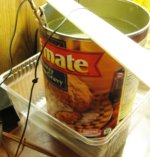
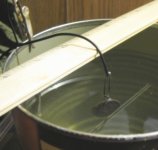
 I ended up using a 5 volt phone charger in one gallon of water, with what ended up being 1/2c baking soda. I used the heat test on the charger till I ended up with the 1/2c. It took a lot more than I thought it would. The can I used ended up really corroding and I changed it after about 10 hours. I lightly sanded the Shell with 320 to get it to shine.
I ended up using a 5 volt phone charger in one gallon of water, with what ended up being 1/2c baking soda. I used the heat test on the charger till I ended up with the 1/2c. It took a lot more than I thought it would. The can I used ended up really corroding and I changed it after about 10 hours. I lightly sanded the Shell with 320 to get it to shine.